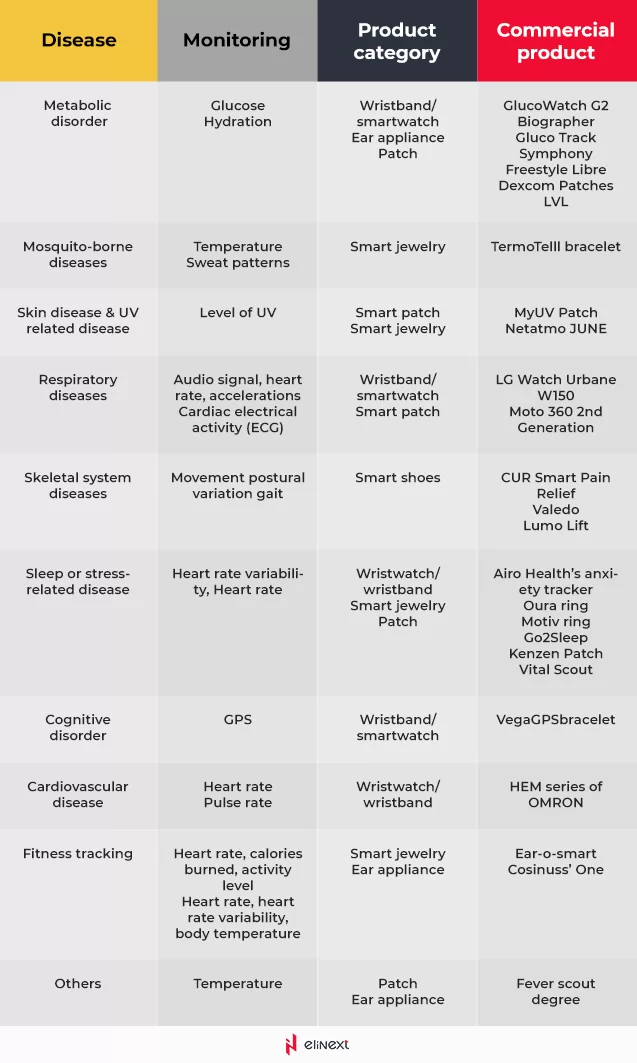Wearables are gaining popularity among customers all over the world. Gartner’s research demonstrates that the global smart wearable market stood at $69 billion in 2020 and is expected to grow by 18.1% to $81.5 billion in 2021. Experts explain the robust growth in the sales of smart devices by the COVID-19 pandemic. People use them to monitor blood oxygen saturation like oximeters and other important health indicators, such as blood pressure, sleep, and so on.
When we say wearables, we mean smartwatches, wristbands, smart shoes, smart glasses, smart clothing, or even digital jewelry. The growing demand for these gadgets is making developers pay attention to this promising sector and create various applications for them. Let’s take a look at what apps they can offer people and whether it’s easy to develop them.
Most Popular Types of Wearables
The Eligraphics below is based on the Statista data and shows the most used types of wearable devices. There are:
- Smartwatch
- Wristband
- Ear-worn
- Smart clothing
- Smart patches
- Head-mounted display

Smartwatch
Users spent almost $21.8 billion on smartwatches in 2020. There are a huge number of different watches with different functionality in the market today. In addition to displaying time and date, these devices notify customers about calls, messages, emails, scheduled events, display weather forecasts, provide sports results and information about the currency exchange rates, and much more. It’s a calendar, calculator, alarm clock, timer, and stopwatch in one gadget. Some models have a built-in speaker and microphone, allowing people to pick up calls without touching the smartphone.
Besides, the smartwatch can be used as a fitness tracker to monitor physical activity. For example, they can count steps, distance, calories burned during exercise, heart rate, and so on. Some models have a built-in GPS module that provides location, speed, and distance data. Modern smartwatches are able to make payments, as well as control music and camera.
Wristband
Wristbands are usually used for fitness and sports activities. They track your steps, average heart rate, sleep quality and duration as well. This data can then be synced to another device, allowing you to see trends and patterns in your activity. For example, you can find out how far you have come in the last week or estimate how many calories you burned in a day. These devices contribute to an improved understanding of your health and activity in daily life.
Many people who start exercising give up their sports activities after a few months with no visible results. However, some studies show that wristbands keep people exercising and adopting healthy habits. Also, they can be integrated with social networks to share your results with friends. Elements of gamification motivate users to compete with other people and receive various rewards for their exercises.
Ear-worn
These smart devices ranked first in the list of the most popular wearables made by the International Data Corporation (IDC). The company even sent them into a separate category known as hearables. Simply put, these are headphones with advanced features and intellectual capacity. It’s clear that in addition to listening to music, a wide range of possibilities opens up for users. Like wristbands and smartwatches, they can monitor heart rate, blood pressure, oxygen in the blood, body temperature, breathing rate, steps, and calories.
If you sync them with your smartphone, you’ll be able to answer calls, listen to messages, listen to the news, receive weather updates, and do other things. What’s more, some smart headphones even feature gesture recognition, allowing you to take a call with a simple nod of your head.
Smart clothing
Do you remember Marty McFly’s sneakers and jacket from Back to the Future? It seems the future has already arrived. For instance, Xiaomi’s 90 Minutes Ultra Smart shoes can count steps and distance, as well as determine whether a person is running, walking, or cycling. Smart clothing is equipped with various sensors for motion, heart rate, pressure, light, temperature, etc. They sync with special applications and give you the necessary data on your physical condition and suggest some actions to improve the state of your health. It’s even better than Marty’s clothes, isn’t it?
Smart patches
Smart patches are widely used in healthcare nowadays. In addition to reading the pulse, steps, and calories, they can measure temperature, blood sugar, blood pressure, do an electrocardiogram (ECG), determine muscle load, human strength, and level of fatigue. For example, BioIntellisense has developed a BioButton smart patch for health monitoring and data analysis platforms. This coin-sized device can be glued to the patient’s chest. It allows doctors to monitor the patient and identify adverse vital signs at the early stages.
Head-mounted display
They are also called virtual reality (VR) helmets or glasses. As a rule, these devices are widely used to watch 3D video and create the effect of presence in video games. But we’d like to tell you about other areas of application of head-mounted displays. Like the above-mentioned gadgets, VR glasses can be useful in medicine. For example, they have been used successfully to treat various phobias and mental disorders.
The specialists at the Institute for Creative Technologies located in Southern California use virtual reality to help veterans cope with PTSD. One of the former special forces soldiers severy suffered because he thought that he didn’t do everything he could to save his comrade. Using a shooter, doctors reproduced the real scene so that he could be sure that he did everything he could. As a result, his condition considerably improved. Another VR app, SnowWorld, is used to alleviate pain in burn patients. They throw snowballs at the penguins in a winter location, which allows them to shift their focus away from their pain.
The VR technology can be successfully used to train the same doctors and other specialists. Future surgeons will be able to perform operations and study human anatomy on the models rather than on living people. Moreover, VR glasses are promising in the field of online sales and design. You can try on clothes without leaving your home or buying them. As for the design, the customer will be able to see the interior in person, and not just by listening to the ideas of an architect or designer.
The table below shows how wearables can be applied to monitor a health condition.
As we can see, smart gadgets continue to find applications in many areas, due to which the demand for them will grow steadily. They are small, light, and easy to use. Therefore, the most important task for developers is to provide people with convenient applications for wearables today.
What Should Developers Take into Account When Developing Apps for Wearable Devices?
Developing solutions for smart gadgets is significantly different from designing web and mobile apps. Their design should be optimized for small screens and adapted to the functionality of wearables. Many companies develop both hardware and software. For example, the first generation of Samsung’s Galaxy Gear smartwatch was run on Android. Then the company designed its own operating system Tizen.
User-friendly design
When developing apps for wearable devices, consider their small size. Therefore, the design of such applications should be simple, convenient, and lack unnecessary details. The user should immediately figure out which buttons to press. Fonts and colors should be chosen in such a way that the user can see the information on the small screen at any time: on a sunny day or in the middle of the night. We recommend combining bright colors and black/white fonts and avoiding pastels and desaturations, ornate fonts, ultra-thin and condensed weights. Feel free to use popular fonts. For example, Helvetica is now ubiquitous among developers because it provides wide letters and moderate spacing. In this case, it is better to choose convenience rather than uniqueness.
Seamless integration
Wearables require connection with other devices, such as smartphones, tablets, hospital management systems, and others. Your app should be able to easily connect to any platform like iOS/Android.
Privacy and security
Wearables collect a lot of private data and transmit it to a server or cloud for analysis. That’s why developers need to make sure that personal information is secured and that the application is compliant with regulatory requirements. For example, if an application is designed to collect health information, it must comply with the international standard Health Level Seven or HL7 that regulates health data handling.
Users of smart devices designed for contactless payments (e.g. through Apple Pay or Samsung Pay services) are concerned about security issues as well. Thus, you should take additional measures to protect their data if you’re going to create any apps for such wearables. For example, large manufacturers often work with white hats to identify any vulnerabilities. Apple offered a record $200 thousand to $1 million reward to anyone who would autonomously hack an operating system.
Bottom Line
As we have seen from the research and expert forecasts, the international wearables market will continue to grow, as will the number of users of applications for these devices. Smartwatches, wristbands, smart patches, and other wearables demonstrate great results in the medical and healthcare fields. Due to the pandemic, people began to take more care of their health and monitor their condition.
In spite of the fact that there are already clear leaders in this area, such as Apple and Samsung, you still have a chance to offer your solution and capture new audiences while a healthy lifestyle is on the rise today. The main thing is to define your central idea and mission and build a design, interface, and functionality around it. While functionality is the basis for a successful app, security, usability, simple design, and an intuitive interface will be decisive factors.
Don’t know where to start? Elinext experts can help you decide on your future application. In particular, they have vast experience in developing various applications for the medical field. For example, the Elinext team created Pneumonia Diagnosis Tool, Workout Plan Generator, Body Tan Scan, and many other mobile and web applications for other industries. Do you have a great idea? Tell us about it and we will help you implement it.










